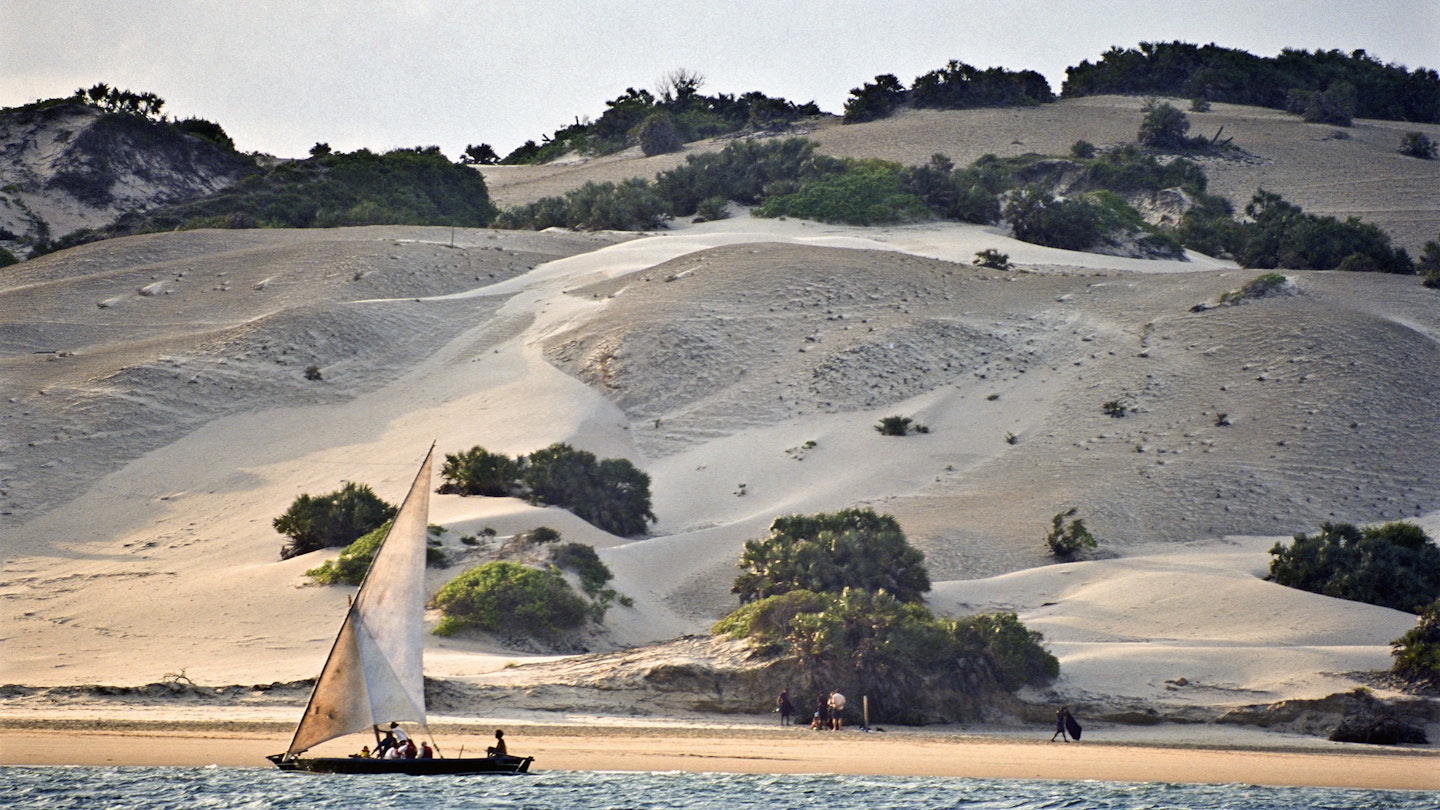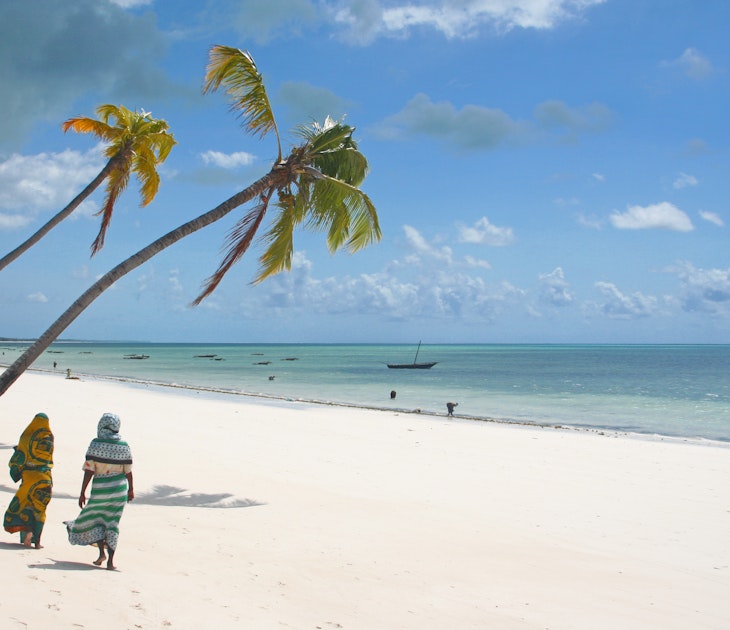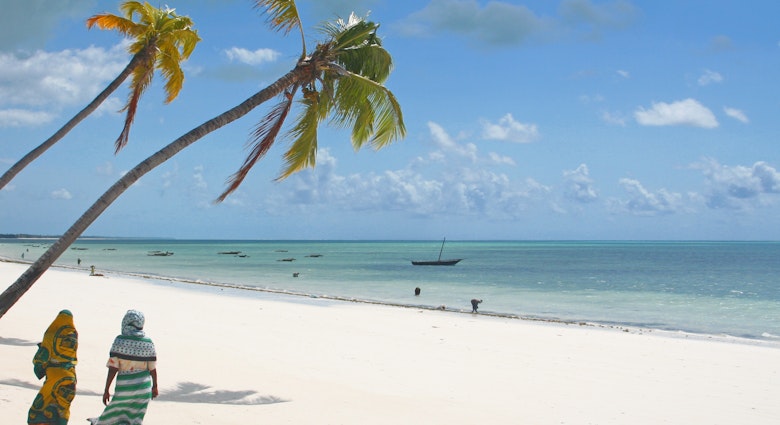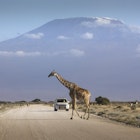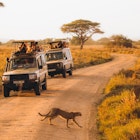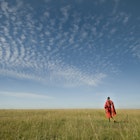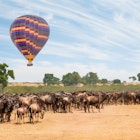Going on safari may be Kenya's biggest attraction, but its 536km (333-mile) Indian Ocean coastline has some of the best beaches in Africa. From the Lamu archipelago in the far north and the resort beaches near Mombasa to lesser-known, quieter shorelines in between, a stint on a Kenyan beach is well worth adding to your trip itinerary.
As East Africa’s largest port, Mombasa has been shaped by new arrivals from around the world for centuries, including British colonists, Arab traders, and Indian and Chinese immigrants, and the region’s cuisine, architecture and population reflect this influence. Being easily accessible, the beaches around Mombasa can get busy, but it’s all relative – they’re unlikely to feel truly crowded.
Whether you’re looking for relaxation, good food, family-friendly spots with calm waters, or aquatic adventures in the form of kayaking, scuba diving or whale watching, Kenya has a beach for it. Here’s our pick of the best beaches in Kenya.
Diani Beach
Best beach for long walks and watersports
About 30km (19 miles) south of Mombasa, Diani Beach is a long-time traveler favorite, with a long stretch of soft, powder-white sand, and an excellent and vast choice of hotels, hostels and serviced beach villas, as well as countless restaurants and bars. Diani is popular for pretty much all the popular beach activities, including standup paddle boarding, kitesurfing, kayaking and deep-sea fishing. You can even go skydiving for views from above.
Diani is a dream for divers and snorkelers, with many dive sites less than an hour away by boat. Reef sharks are a big draw, as is spotting endangered hawksbill and green turtles. From November to February, you might see whale sharks. For kids, glass-bottomed boat tours offer an easy glimpse of the underwater world.
If you’re after a safari fix, the rainforest park of Shimba Hills National Reserve is 16km (10 miles) inland, and it’s home to elephants, monkeys, mongooses, bird species and the endangered sable antelope. Inside the reserve is the Mwaluganje Elephant Sanctuary, created for elephants to freely roam around this area.
Galu Beach
Best beach for eco-tourism and kitesurfing
Galu (sometimes called Galu Kinondo) is often seen as an extension of Diani Beach, and it's another endless stretch of coastline south of Mombasa. This patch of sand is a little more secluded and less developed than Diani, and there’s more coastal scrub. Kaya Kinondo Sacred Forest is the last remaining jungle on the Kenyan coast, home to vervet and colobus monkeys, and it's a sacred site for local communities.
While white sands are the big ticket, the eco-tours run by Colobus Conservation are worth investigating. The organization was set up to protect these threatened primates and conserve their habit after locals voiced concerns over the increasing deaths of colobus monkeys on busy Diani Beach Road. Your tourist dollars will go some way to support research, education, animal welfare and habitat protection.
Galu Beach is also popular with kitesurfers and paddle boarders, and the Polish-run KiteMotion kitesurfing school is a good first port of call if you want to join in. Snorkelers and divers can swim among scorpion fish and moray eels, as well as rarer fish such as sea horses and ghost pipe fish.
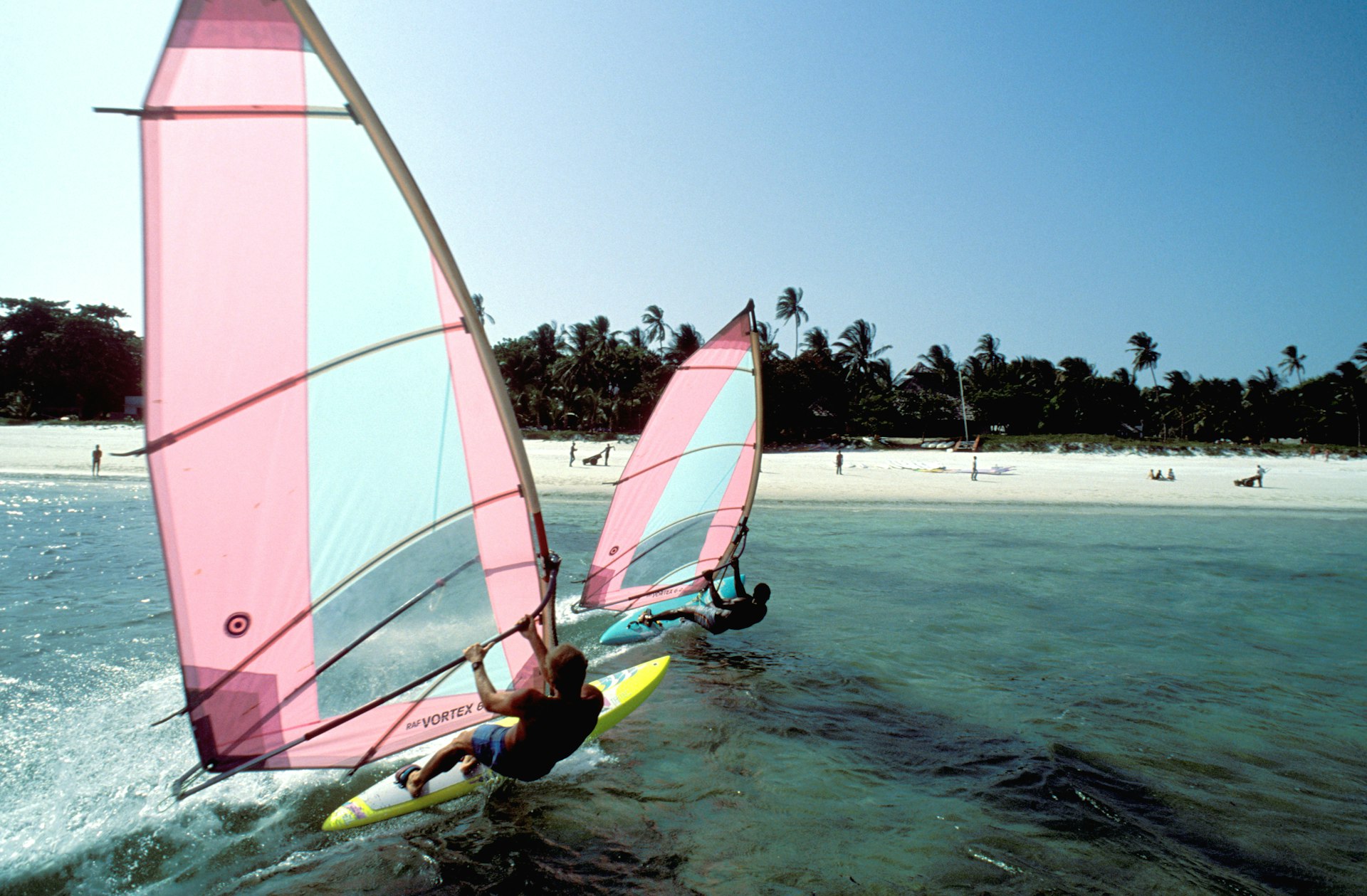
Nyali Beach, Mombasa
Best beach for easy access from Mombasa
When people talk about Mombasa’s beaches, they often mean the long stretches that lie north and south of the city, such as Diani and Watamu. But Nyali, part of a larger residential area just north of central Mombasa, has plenty going on to suit all ages, and it’s one of the most accessible and convenient stretches of sand.
Nyali’s long, white-sand beach has a good selection of hotels and restaurants across all budgets, and you can enjoy a variety of beach activities and watersports. It’s not the most beautiful of Kenya’s beaches, but with the New Nyali Bridge connecting Nyali to Mombasa Island, it’s easy to reach the Old Town and sights such as ancient Fort Jesus.
A good base is Tamarind Village, a stylish complex of serviced apartments on Mombasa Harbor with gorgeous views over the water to Mombasa Island. Its white exterior and high arches are a design homage to traditional Arab architecture on the Swahili coast. Its popular, open-sided Tamarind restaurant is excellent for seafood, and you can also book a trip on a dhow (traditional sailboat) for a crewed sunset cruise around the harbor. You can request drinks and snacks, or even a full dinner, or bring your own supplies.
Kikambala Beach
Best beach for local atmosphere
About 33km (21 miles) north of Mombasa, Kikambala Beach is not the most accessible spot – the road ends a few hundred meters away from the shore – but if you like quiet sands and snorkeling, it’s worth the effort. The sand is blinding white and at low tide, you can stroll out to the coral reef. It’s a popular beach with the local community, which makes it particularly atmospheric at the end of the day, with children kicking soccer balls around and people relaxing with cold beers at small beach kiosks.

Watamu
Best beach for snorkeling and marine life
About 108km (67 miles) north of Mombasa, the coral gardens of Watamu Marine National Park and Reserve are home to parrotfish, angelfish, three species of turtles and many more marine species, making this an underwater paradise. If you’re here between November and February, there’s a good chance of spotting whale sharks and manta rays, while July to October is the season for humpback whales. Tribe Watersports can arrange kitesurfing and other water activities.
Watamu is made up of three bays – Watamu, Blue Lagoon and Turtle – and they’re all white-sand, aquamarine, coconut palm-lined natural wonders. What makes this area particularly special are the nearby wetlands and mangrove forests – the Arabuko Sokoke Coastal Forest is one of the largest tracts of coastal forest in Africa and a thriving habitat for wildlife, including elusive elephants, various reptiles and amphibians and the adorable-looking Sokoke scops owl.
While Watamu is still a relatively sleepy beach town, a growing number of hotels have put it on the map, including the popular Hemingways, named in tribute to the US author who spent a vacation here deep-sea fishing. Others, such as Ocean Sports & Turtle Bay have raised Watamu’s profile for watersports; the hotel's activity center can arrange scuba dives, fishing trips, kayaking and windsurfing lessons.
Kilifi
Best beach for cool, creative vibes
In recent years, Kilifi has come into its own as young professionals have made a base here, leading to an explosion of cool cafes and bars, coworking spaces and concept venues such as The Food Movement and FoMo, where artist studios, an organic farm and market days come together in one creative space. Kilifi is also the setting for the annual three-day Beneath the Baobabs Festival – Africa’s first carbon-neutral festival – mixing East African music and culture with a focus on sustainability.
Kilifi is around 35km (22 miles) south of Watamu at the mouth of Kilifi Creek, with a mostly local population of Giriama and Chonyi people from the Mijikenda tribe. Palm-lined Bofa Beach is a beautiful spot and home to the lively beach bar and kitesurfing center, Salty’s Kitesurf Village. The south side of Kilifi Creek is home to the smaller Shauri Moyo Beach with more white sand.
The creek itself, an estuary of the Goshi River, is a haven for birdlife. Take a boat to the bird island in the middle of the creek to see fish eagles and flocks of southern carmine bee-eaters. Kilifi is also a good base for a trip to the Watamu Marine National Park and Reserve, one of Kenya’s oldest marine parks. Take a boat to snorkel and dive among groupers, lionfish and large rays and whale sharks in season.
On land, Kilifi is home to the Mnarani Ruins, the archeological remains of a centuries-old Swahili settlement on a bluff overlooking the creek. The site includes two 15th-century Mnarani mosques and a 900-year-old baobab tree.
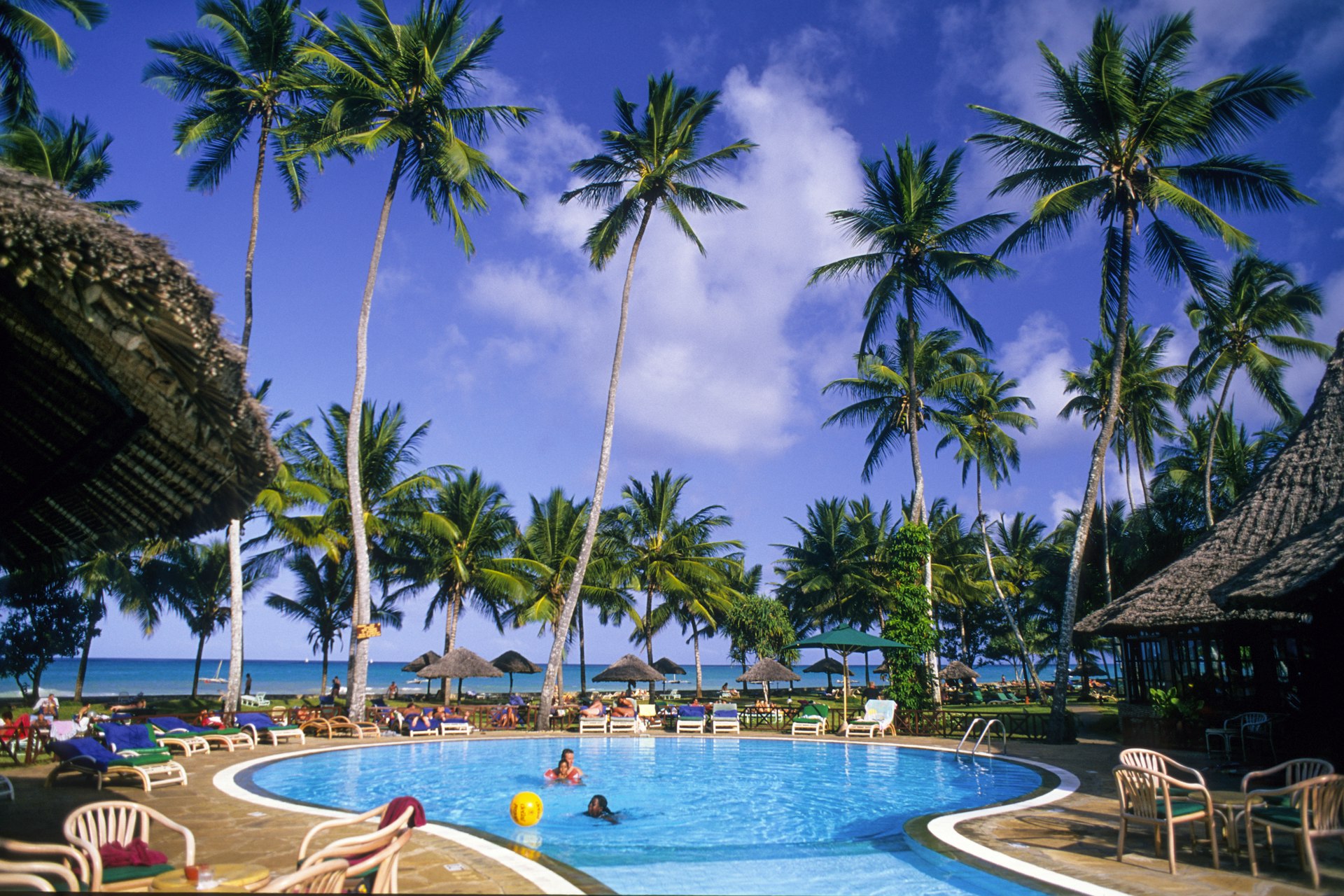
Malindi
Best beach for Italian flavors
Malindi is one of Kenya’s most intriguing beach towns. While it has a predominantly Muslim population, it’s also known as 'Little Italy' after the Italian-run Broglio Space Center opened in the late 1960s and a growing Italian community made a home here. While fewer Italian residents live here permanently today than in Malindi's heyday, the town is still home to an above-average number of Italian restaurants, gelaterias and grocery stores selling pasta and Parmesan cheese.
Malindi has a long and lovely stretch of beach, and while the town has a somewhat faded feel, that’s also part of the charm. Lodges and resorts line the beach road leading to Malindi town, including the unusual sculpture-park-meets-hotel, White Elephant, owned by an Italian art collector. Two of the best Italian restaurants in the area – Osteria and Baby Marrow – are also on this beach road.
Lamu Island, Lamu Archipelago
Best beach for experiencing Swahili culture
Slow travel rules on Lamu Island, and visiting his dune-dusted archipelago can feel like a step back in time – traditional dress, donkeys for transport (cars for private use aren’t allowed) and traditional trades such as carpentry and boat-building are still commonplace. Continuously inhabited for more than 700 years, the 13th-century port city of Lamu Town is one of the oldest and best-preserved Swahili settlements in East Africa, and you’ll see African, Asian and European influences on the islands' architecture, particularly the ornate doors.
As well as exploring the beaches (Shela Beach is particularly stunning), a sunset dhow boat trip around Lamu island and into the mangrove forests is a must. These beautifully carved traditional sailing vessels were once used to ferry spices and other goods between Africa, Asia and the Arabian Peninsula. Today, they take people on sunset cruises, snorkeling day trips, and even overnight trips where you can swim in sparkling phosphorescence and sleep on deck under the stars.
In Lamu Town, make a trip to Ali’s boatyard to see the FlipFlopi Dhow, the world’s first recycled plastic sailing boat, part of a project to reduce waste in coastal communities.

